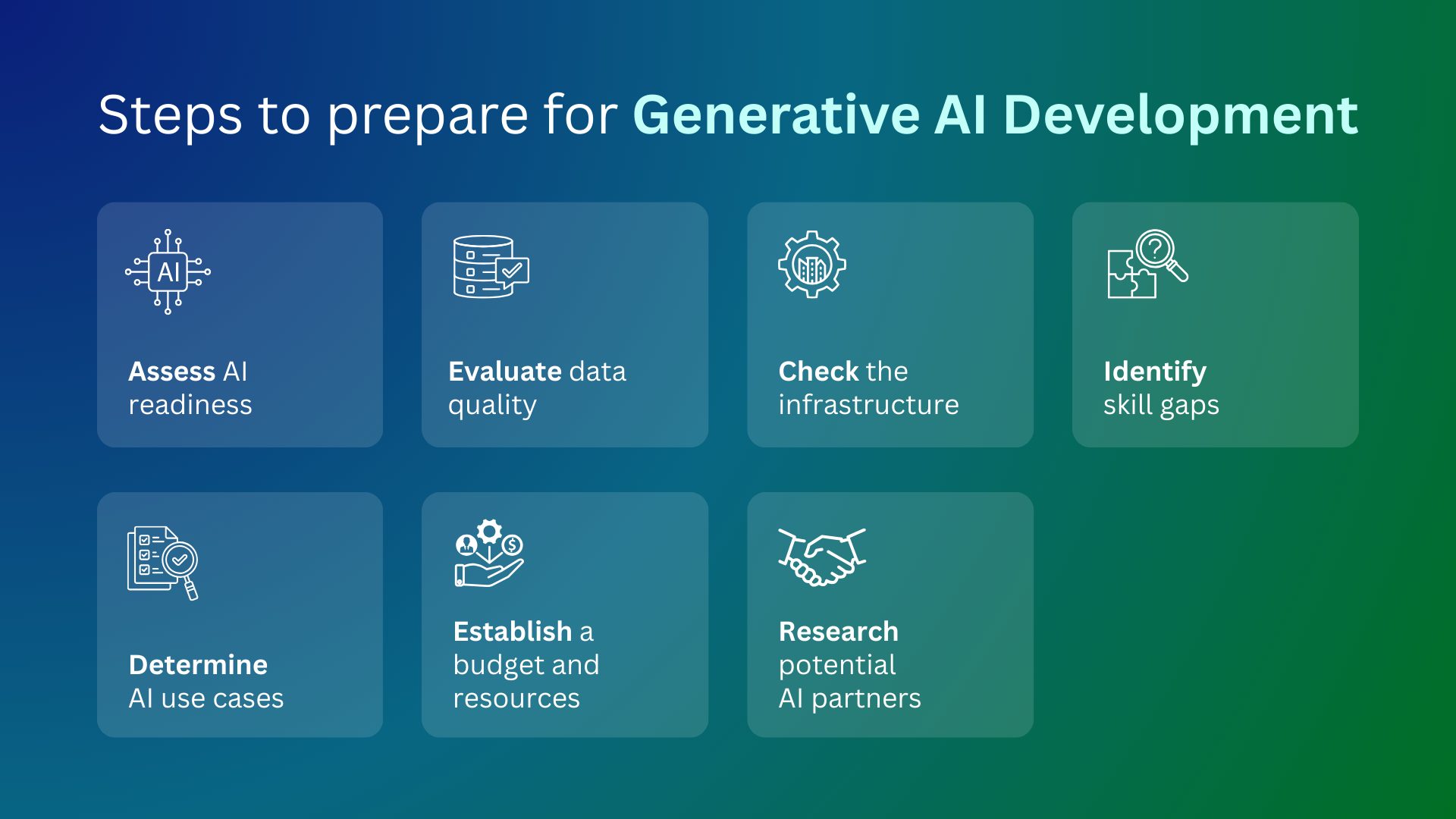
Generative AI has moved beyond stand-alone chatbots. The real value now comes from custom generative AI software development: building and integrating AI applications directly into the systems that run your business: CRM, ERP, data warehouses, workflow tools, and customer-facing products. Companies that treat AI as a core capability, not a side experiment, are driving measurable gains in efficiency, customer experience, and innovation.
What Is Generative AI Software Development?
At first, generative AI platforms like ChatGPT, Gemini, and Grok were tools employees used to create ready-to-use content such as text, images, audio, video, or code. They sped up everyday tasks. Now, it is becoming more than that for businesses.
For companies today, the value is in generative AI software development: integrating AI into existing systems, data pipelines, and infrastructure, and building custom applications. Instead of a standalone chatbot, you get AI copilots embedded in your CRM and ERP, automated document pipelines (classify, extract, validate, file) that tie directly into your workflows, and knowledge search connected to your private data with audit trails and access control.
In short, the focus has shifted from ad-hoc or one-off prompts to AI that both integrates with core business systems and enables custom applications to enhance operations and client service.
Real Statistics Driving Generative AI Adoption in Business

Industry data shows just how quickly this shift is happening. Gartner projects that by 2026, more than 80% of enterprises will have used GenAI APIs/models or deployed GenAI-enabled applications in production — an impressive leap from just 5% back in 2023. This isn’t a passing trend; it’s becoming a necessity for staying competitive.
Key Industries Leading Adoption
The value shows up in three critical areas:
- Operational Efficiency:
- Generative AI can automate up to 70% of repetitive work and boost developer productivity by 20–45%, adding as much as $4.4 trillion in annual value.
- The real impact comes when AI is plugged into everyday tools: customer care systems that now handle half of routine interactions, CRMs and marketing platforms that can personalize campaigns, knowledge bases that make answers easier to find, developer environments that speed up coding, and IT workflows that eliminate manual busywork (McKinsey).
- Customer Engagement:
- Customers expect personalization. In fact, 73% want companies to understand their unique needs, and 80% say the experience matters as much as the product itself.
- Generative AI development is how brands are already delivering that level of personalization at scale (analyzing user behavior in real time to tailor interactions, offers, and services) (Salesforce).
- Innovation Capacity:
- Beyond day-to-day work, companies are also building generative AI applications that help drive customer-focused innovation. These internal tools are cutting R&D time-to-market by 10–20% and lowering costs by up to 20%.
- Examples include a shipbuilder reducing engineering rework by 30% with AI agents, a consumer goods company using an AI “lab companion” to cut formulation time in half, and a biopharma company applying large language models to draft clinical reports three months faster (BCG).
The takeaway is clear: generative AI development is emerging as a practical lever for growth. Companies that start embedding it into their business today are capturing efficiency gains, strengthening customer relationships, and accelerating innovation, while also laying the groundwork for future-ready operations.
Discover how generative AI strengthens customer relationships and accelerates business growth in our article: Boosting Customer Growth with Generative AI
Choosing the Right AI Approach: Public, Integrated, or Custom?
Not every business has to build custom AI from the start. Companies typically weigh three approaches, depending on their goals, resources, and industry requirements:
- Public Solutions (ChatGPT, Gemini, Copilot, Grok, etc.)
- Pros: low cost, quick deployment, easy to experiment with
- Best for: simple use cases like internal knowledge management, content generation, or automating routine tasks
- Limitations: Lacks customization for sensitive data or complex workflows.
- Integration of AI into Existing Systems
- Pros: cost-effective next step beyond public tools; embeds AI into CRM, ERP, workflow tools, and data platforms; improves efficiency and customer engagement
- Best for: businesses looking to streamline operations with solutions like automated document pipelines, AI copilots inside enterprise apps, or personalized campaigns at scale
- Limitations: May not fully address unique business models or regulations.
- Custom Generative AI Applications
- Pros: built around your data, workflows, and business model; provides full control over compliance, security, and performance; scales to mission-critical processes
- Best for: organizations needing strong differentiation or operating in regulated industries (healthcare, finance, government) where public or integrated solutions alone aren’t sufficient
- Limitations: Higher upfront investment, but yields superior ROI.
Each path offers a different balance of cost, control, and impact. You do not have to stick to only one. The kEach path offers a different balance of cost, control, and impact. You don’t have to commit to just one; many companies experiment with public tools, integrate AI into existing systems where it creates quick wins, and explore custom development for long-term competitive advantage. The key is knowing how to choose the right approach depending on your business priorities and project goals.
7 Steps to Build Your AI Strategy

Once you understand the available approaches, the next step is building a strategy that ensures your AI adoption is structured, scalable, and aligned with your organization’s objectives. These seven steps help frame the journey.
01. Assess AI Readiness
| Is our organization prepared to adopt AI now?
Evaluate leadership commitment, appetite for change, and alignment with business priorities. Without organizational buy-in, even well-designed projects will stall. Consider whether AI adoption fits your culture: is there room for experimentation, or is risk-aversion too high? A clear readiness check helps prevent wasted investment.
02. Evaluate Data Quality
| Do we have reliable, consistent, and well-structured data?
High-quality data is the backbone of every AI initiative. Identify silos, inconsistencies, or gaps early. If your data is fragmented across multiple systems, prioritize integration before deploying AI. Companies that invest in data governance upfront see faster, more reliable AI outcomes and avoid costly rework later.
03. Check the Infrastructure
| Can our systems handle AI workloads at scale?
Review your cloud platforms, APIs, and storage capabilities. Outdated infrastructure not only slows adoption but also limits model performance. A scalable architecture with flexible compute power and secure data pipelines is essential for handling enterprise-grade AI workloads.
04. Identify Skill Gaps
| Do we have the right talent in-house, or do we need outside support?
AI success depends on skills such as data engineering, model lifecycle management, and compliance governance. Map your team’s current strengths and weaknesses. Some organizations train existing staff; others partner with vendors or consultants to accelerate progress. Be deliberate in choosing the right mix of internal capacity and external expertise.
05. Determine AI Use Cases
| Where will AI deliver the biggest impact first?
Start with high-value, low-resistance use cases – areas where AI can generate measurable results without major disruption. Examples include automating repetitive workflows, accelerating customer service, or streamlining compliance checks. Early wins build credibility, boost employee confidence, and lay the foundation for larger-scale initiatives.
06. Establish a Budget and Resources
| What level of investment are we ready to commit long term?
Generative AI is not a one-time project; it requires ongoing investment in retraining models, upgrading infrastructure, and maintaining compliance. Build a budget that reflects both short-term pilots and long-term scaling. Secure executive sponsorship early to ensure AI is funded as a strategic priority, not an experimental expense.
07. Research Potential AI Partners
| Who can accelerate our journey and fill critical gaps?
Most companies won’t succeed by going alone. Evaluate vendors, cloud providers, and consulting partners based on technical depth, domain expertise, and proven results in your industry. The right partner will not only provide tools but also help you navigate governance, security, and change management.
Why Investing in Generative AI Now Matters
Delaying adoption carries a cost. Competitors that embed AI today are not only improving performance but also building future-ready capabilities that will be difficult and expensive to replicate later. The question is no longer if generative AI will be part of your business, but how soon and how strategically you will adopt it.
Start where the impact is visible, integrate AI into the systems and processes that matter most, and scale with custom solutions when differentiation is essential. By aligning adoption with organizational goals, leaders can turn challenges into opportunities and secure a lasting competitive advantage in an AI-driven economy.
Looking for Innovative AI Solutions or AI Experts?
LinkTree Corp is a trusted name in providing advanced AI solutions and connecting businesses with top AI talents. Whether you need state-of-the-art AI integration for cloud-based or web app development, or you’re seeking skilled AI professionals to join your team, we’re here to help. Fill out our enquiry form for a tailored solution that perfectly aligns with your business needs.
Connect Now!





